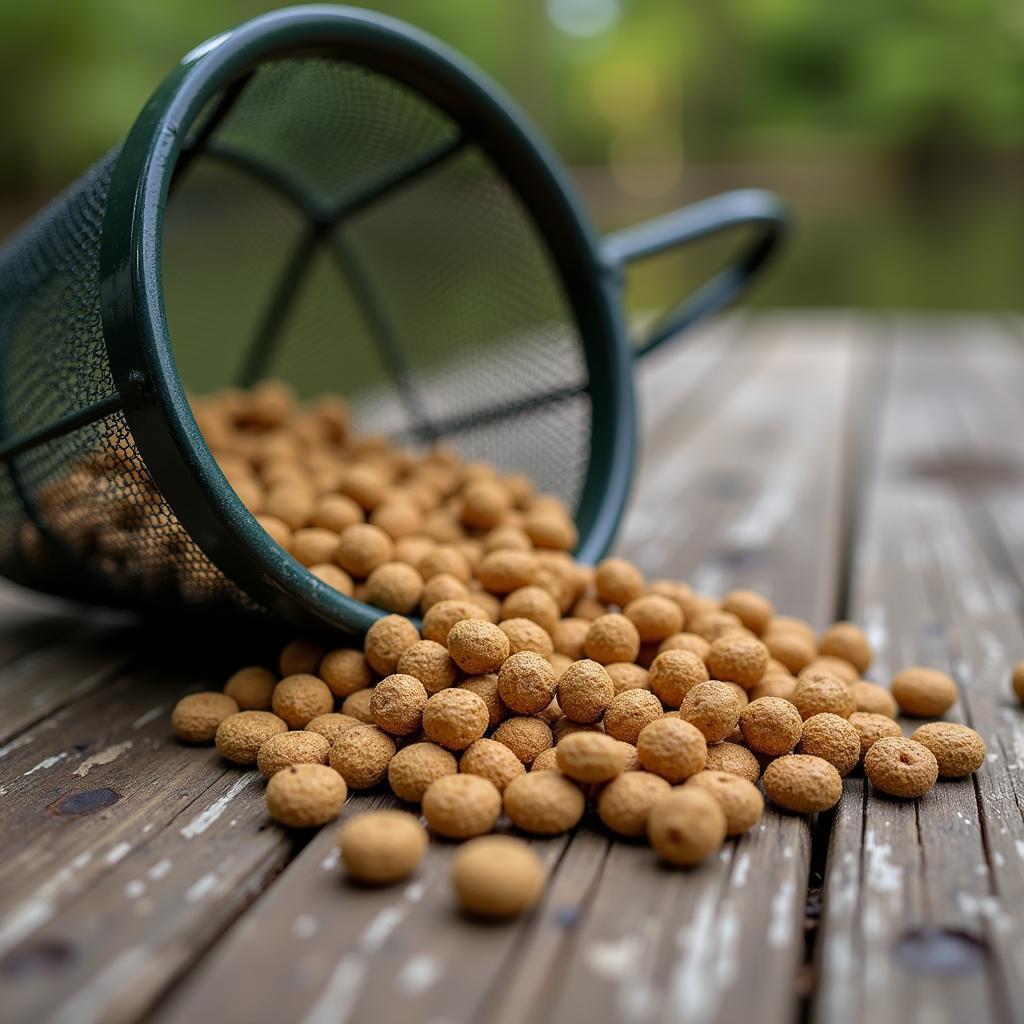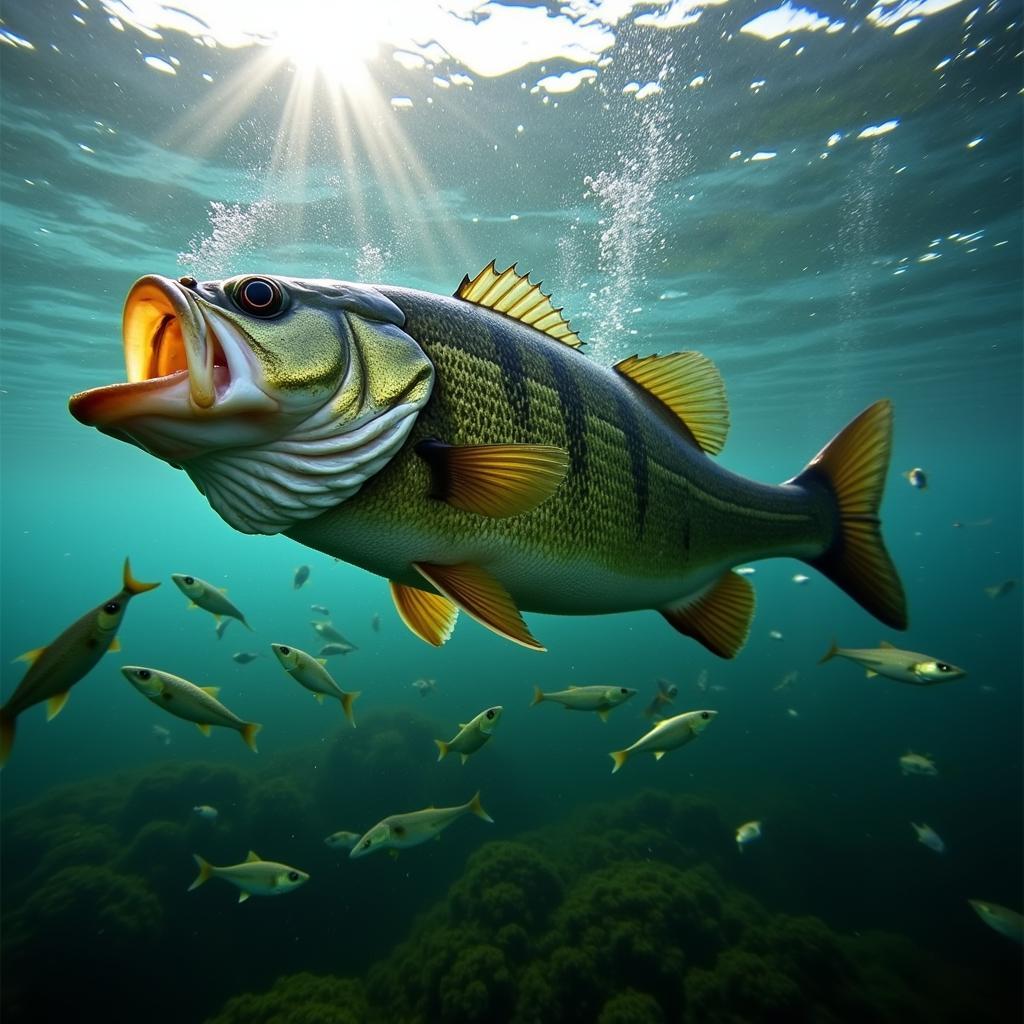When it comes to bass fishing, having a well-stocked and healthy bass pond is key. But did you know that what you feed your bass plays a crucial role in their growth, health, and overall fishing experience? Choosing the right bass pond food can make all the difference. Let’s dive into the world of bass pond nutrition and discover the best ways to keep your fish happy and thriving.
Understanding Bass Diet and Nutritional Needs
Bass are carnivorous predators, meaning their diet primarily consists of meat. In their natural environment, they feed on smaller fish, insects, crustaceans, and even frogs. When stocking your pond, it’s essential to provide a diet that mimics their natural feeding habits to ensure optimal growth and health.
A balanced fish food for bass and bluegill should contain a high percentage of protein (around 30-40%), a moderate amount of fat (10-15%), and essential vitamins and minerals. These nutrients are essential for:
- Growth and Development: Protein is crucial for muscle growth and repair, ensuring your bass grow to their full potential.
- Energy Production: Fat provides a concentrated source of energy, allowing bass to actively hunt and thrive.
- Immune Function: Vitamins and minerals support a healthy immune system, making your bass more resilient to diseases.
Types of Bass Pond Food
There are various types of Bass Pond Food available on the market, each with its pros and cons:
1. Floating Pellets
Floating pellets are a popular choice for pond owners as they offer easy monitoring of feeding habits and prevent overfeeding, which can lead to water quality issues. These pellets are designed to float on the surface, allowing you to observe how much your bass are consuming.
 Floating Bass Pellets
Floating Bass Pellets
2. Sinking Pellets
Sinking pellets are ideal for bottom-feeding fish species that may be present in your pond, ensuring all fish have access to a nutritious meal. These pellets sink to the bottom, catering to the feeding habits of catfish or other bottom dwellers that share the habitat with your bass.
 Sinking Bass Food Pellets Underwater
Sinking Bass Food Pellets Underwater
3. Live Food
Live food, such as minnows, worms, and crickets, provides a more natural and enriching feeding experience for your bass. Introducing live food can also encourage natural hunting instincts and provide mental stimulation.
“Offering a variety of food sources, including live food, can enhance the overall health and vitality of your bass population,” says Dr. Susan Miller, a renowned aquatic veterinarian.
 Bass Feeding on Live Minnows
Bass Feeding on Live Minnows
Choosing the Right Food for Your Bass Pond
Selecting the right pond fish food 50 lb for your bass pond depends on several factors:
- Age and Size of Your Bass: Younger, smaller bass require a diet higher in protein to support their rapid growth, while mature bass benefit from a slightly lower protein and higher fat content for energy maintenance.
- Water Temperature: Bass metabolism slows down in colder water, so they require less food during winter.
- Pond Stocking Density: A higher fish population requires more frequent feeding to ensure all fish receive adequate nutrition.
Feeding Schedule and Techniques
Establishing a regular feeding schedule is vital for the health and growth of your bass. Here are some tips for an effective feeding routine:
- Feed Small Amounts Frequently: It’s better to feed your bass small amounts multiple times a day than one large feeding. This prevents overfeeding and helps maintain water quality.
- Observe Feeding Habits: Pay attention to how much your bass consume within 5-10 minutes and adjust the feeding amount accordingly.
- Consider Seasonal Changes: As mentioned earlier, bass metabolism changes with water temperature. Adjust the feeding frequency and amount according to the season.
Conclusion
Providing your bass with the right nutrition is key to maintaining a healthy and thriving pond. By understanding their dietary needs, choosing appropriate food types, and establishing a consistent feeding schedule, you can ensure your bass grow to their full potential and provide you with an enjoyable fishing experience for years to come. Remember, a well-fed bass is a happy bass!
FAQs
1. How often should I feed my bass in the summer?
During the warmer months, when water temperatures are higher, bass are more active and require more frequent feeding. Aim to feed them twice a day, once in the morning and once in the evening.
2. Can I feed my bass dog or cat food?
While dog and cat food may contain protein, it lacks the essential nutrients and fatty acids specifically required for bass. Feeding them such foods can lead to health problems and negatively impact water quality.
3. What should I do if my bass are not eating?
Loss of appetite in bass can be a sign of stress, disease, or poor water quality. If you notice your bass are refusing food, it’s crucial to check your water parameters and observe for any signs of illness.
4. How can I improve the growth rate of my bass?
Providing a high-quality, protein-rich diet, maintaining good water quality, and ensuring adequate space in your pond are essential factors for optimal bass growth.
5. Should I continue feeding my bass during the winter?
Bass metabolism slows down significantly in cold water, and they may not eat as much or at all during winter. Reduce feeding frequency and amount as water temperatures drop, and stop feeding altogether if your pond freezes over.
Looking for more information?
For more tips on creating the ideal environment for your bass, check out our article on fish food for bass. Need to stock up on high-quality bass pond food? We’ve got you covered! Visit our online store and browse our wide selection of pond fish food 50 lb.
Have other questions? Contact our team at:
Phone: 02437655121
Email: minacones@gmail.com
Address: 3PGH+8R9, ĐT70A, thôn Trung, Bắc Từ Liêm, Hà Nội, Việt Nam.
We’re here to help you create the best possible habitat for your bass and ensure a successful fishing experience!